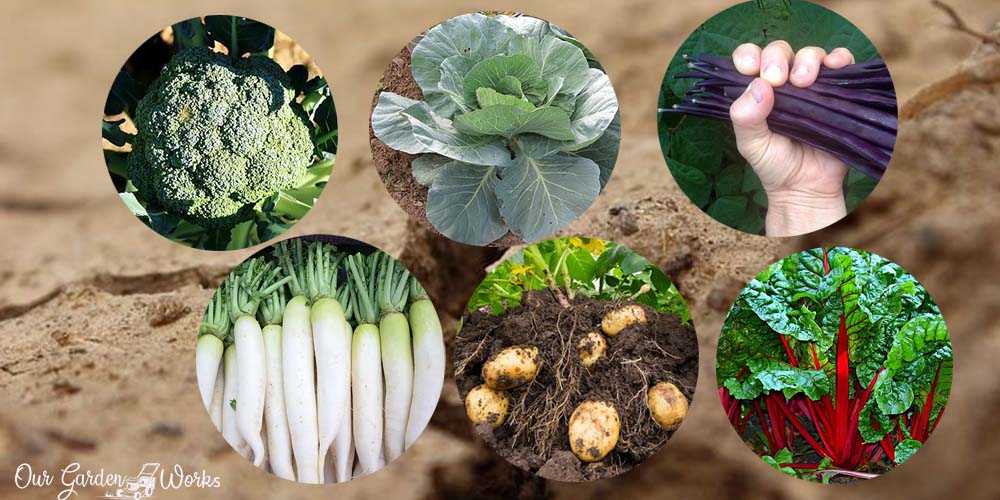Show clay soil to any gardener, and you’ll find most of them not interested in growing anything on them. The good thing is some vegetables that grow in clay soil love its growing environment, flaws and all.
Clay soil is a challenging type of soil to deal with because it can get too mushy when wet and too hard when dry.
However, even the worst kind of soil can be ideal for growing with a little bit of adjustment. It remains a good growing medium when given the right types of plants that can benefit from its qualities.
Good Qualities of Clay Soil
Clay soil has been popular for being the last option to grow plants and an effective material to build pots. With that, gardening soil potential has been overlooked.
Here are the qualities on the positive side of using clay soil:
- Rich in nutrients: According to Oregon State University, clay soil holds many plant nutrients since they are too dense.
- Great moisture retention: Its moisture holding capacity is its best and worst feature. Without other soil amendments, clay soil can be too clumped for the roots to move freely. However, with the right soil mix, it can hold enough water to sustain the needs of moisture-loving plants.
- Increases the effect of slow-release mineral fertilizers: Fertilizers and other nutrients also don’t leak fast, unlike in sandy soil. It helps keep the nutrients in the soil until the roots eventually absorb them.
Clay soil alone won’t make it good for growing vegetables. It is necessary to mix it with organic matters like sand, compost, and fine gravel. Mixing new ingredients helps prevent soil compaction and promotes good soil aeration.
Oxygen in the soil helps the roots of vegetables to breathe as well as the beneficial microorganisms that help break down the organic matter.
6 Vegetables That Grow In Clay Soil
Once you’ve figured out how to work on clay soil, here are some of the vegetables that can thrive in what it can offer:
#1 Broccoli
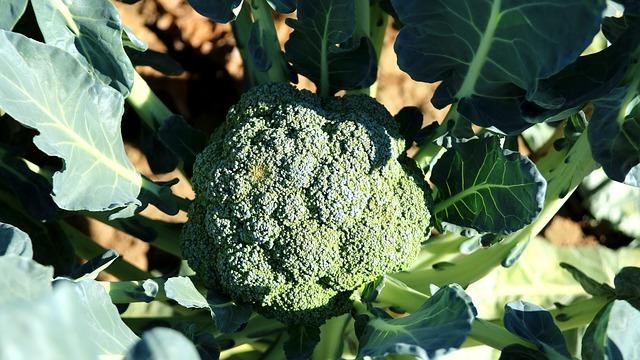
Broccoli is a moisture-loving plant that can thrive in well-drained sandy and clay loam soil – a moisture-loving plant.
It has shallow roots but needs to develop deep roots to develop a good broccoli head. Another good feature of broccoli is it is capable of a second harvest after you pick the first head.
How to grow broccoli in clay soil?
Plant broccoli before summer comes. It thrives in cool weather, so you’ll need to plant it early.
If you plant seeds in early spring, you can get a harvest by early summer while planting in late summer will give you a harvest in the last weeks of fall.
Here are other growing conditions you need to consider:
- Temperature: 65 to 75 F
- Climate zones: USDA hardiness zones 2 to 11
- Growing period:
- Transplants: 6 to 8 weeks (summer crop)/5 to 6 weeks (fall crop)
- Seeds: 65 to 70 days
- Planting distance: 1 ½ or 2 feet
- Fertilization: Broccoli is a heavy-feeding vegetable. Apply a 10-10-10 or 5-10-10 NPK fertilizer in the clay loam soil before planting the seeds or transplants.
- Harvest: Harvest broccoli when the head is about 3 to 6 inches high and as long as the flower buds are closed. When the flowers have started to bloom, it’s too late to harvest the head.
Did You Know? Broccoli is an active flower. It is an edible flower and should be harvested long before the buds develop. Once the flowers start to bloom, the head will no longer be ideal for consumption and can only be used for producing seeds.
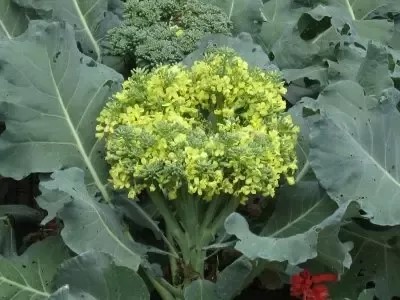
Tips in Growing Broccoli in Clay Loam Soil
Provide a consistent water supply every morning to allow the leaves to dry throughout the day.
Broccoli is among the vegetables that grow in clay soil because of its moisture requirements. The water should reach deep into the clay-loam soil with approximately a 6-inch depth to help promote deep roots and a bountiful harvest.
You might also like: How To Grow Broccolini In Your Vegetable Garden At Home?
#2 Potatoes
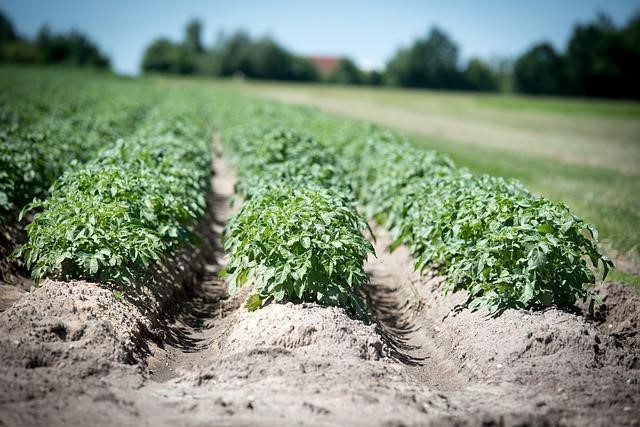
Potatoes are very versatile vegetable varieties that can grow in most soil conditions. It can thrive in heavy clay soil as it helps break the compaction. Potatoes also help clay soil be more conducive for growing other types of vegetables.
How to grow potatoes in clay soil?
Potatoes are sun-loving vegetables. They hate the cold but love a lot of moisture. You can either grow them from seeds or from store-bought seed potatoes that undergo a process called chitting.
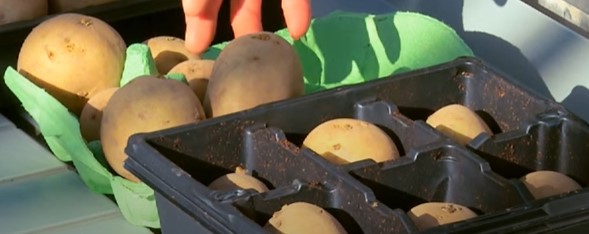
In chitting tomatoes, you allow the seed potatoes to sprout in an egg tray to keep them upright. The eyes or buds of the potatoes are placed on the upper part to receive more sunlight. It is where the new shoots will sprout later on. Once the new potato shoots reach 1.18 inches (3 cm) or more, they become ready for planting in the soil.
The Desiree is the best potato variety to grow in heavy clay soil. It has a high resistance to drought and soil-borne diseases. Regardless of potato variety, here are the ideal growing conditions for potatoes:
- Temperature: 68 to 77 F
- Climate zones: All zones but with varying growing methods
- Growing period: 80 to 100 days
- Soil pH: 5.8 and 6.5
- Planting distance: 30 cm. t0 60 cm. apart in a 6 to 8-inch deep trench
- Fertilization: Potato is a heavy-feeding tuber. Apply a 10-10-10 or 20-10-10 NPK fertilizer before you plant the seed potatoes.
- Harvest: Potatoes are ready for harvest when their leaves have started to wilt and die back. You may check if they are ready for harvest by observing the skin. If the skin is securely attached to flesh, they are available for harvest. However, if the skin gets scrubbed easily, you need to harden the potatoes further by leaving them in the soil for a few more days.
#3 Daikon Radish
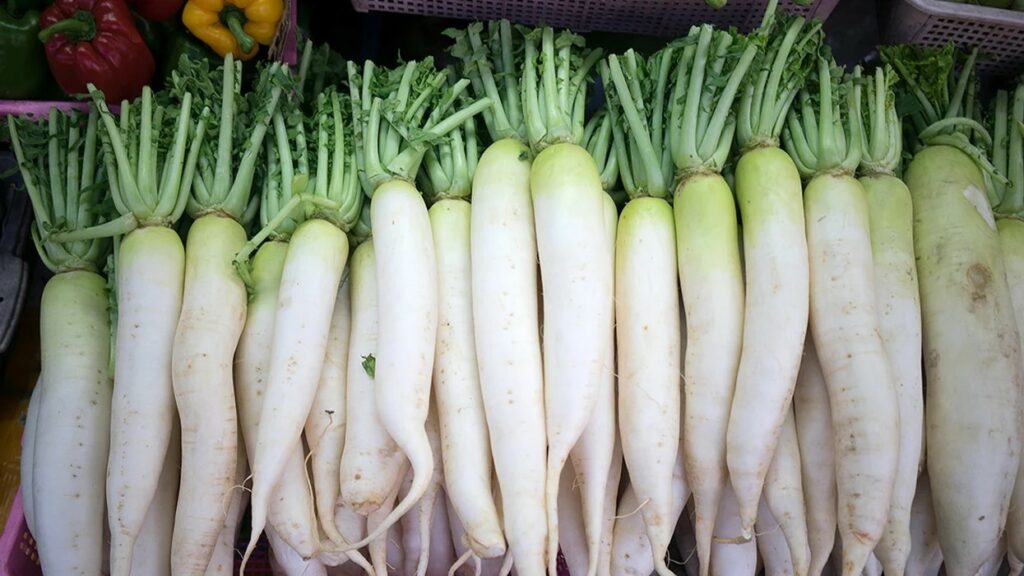
Known as a staple in Japanese cuisine, daikon radish is a famous vegetable that can thrive and revive clay soil.
Asian farming practices involve growing daikon radish to soften hard clay soil before planting other garden plants and vegetables. Among the best vegetables that grow in clay soil, daikon has a well-known reputation as a natural rototiller.
How to grow daikon radish in clay soil?
As a root and a bio-drill, daikon radish digs deep into the clay soil, reaching 16 inches, and creates pathways for water. It helps soften up the clay soil without any laborious effort from gardeners, making it a perfect cover crop.
Daikon radish is a winter radish that benefits from the slow temperature change in clay soil during spring.
- Temperature: 50 F to 65 F
- Climate zones: USDA hardiness zones 2 to 11
- Growing period: 70 days
- Soil pH: 6.0 to 6.8
- Planting distance: 4 to 6 inches apart and 6 inches depth in the soil
- Fertilization: For a larger daikon root, add phosphorus and potassium-rich fertilizer. Adding too much nitrogen or compost may cause more leaves than chunkier roots.
- Harvest: Daikon radishes are ready for harvest after 20 to 60 days. Harvest your roots when the leaves start to droop and dry. First, cut the leaves and keep them since they are also edible. Then slowly pull all the daikon roots.
#4 Cabbage
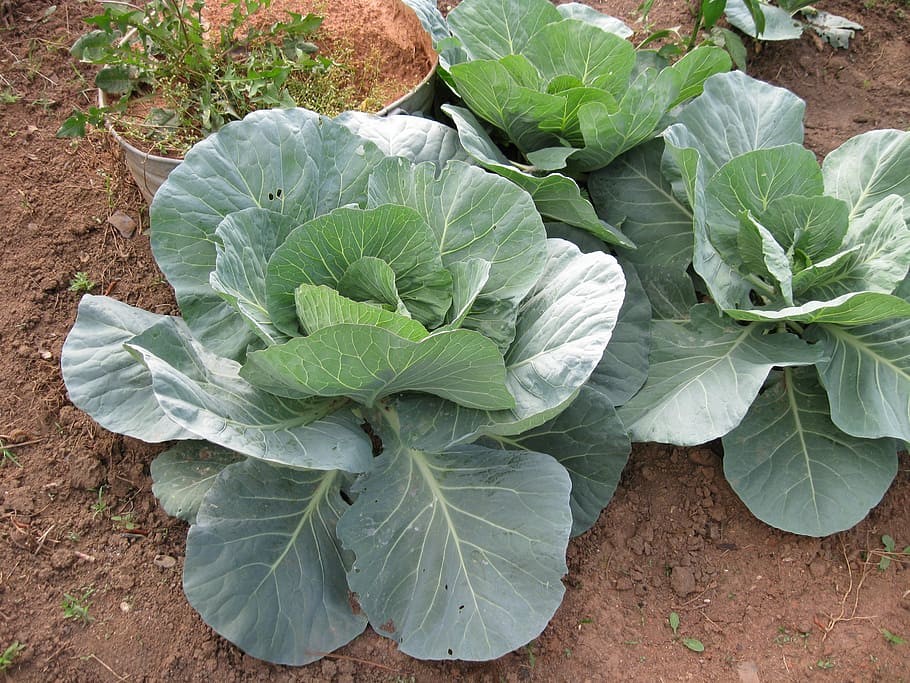
Heavy clay soil helps provide root support for cabbage. Since cabbage is also a cool-season vegetable, it benefits from the slow temperature adjustment of clay soil which remains cold in early spring. It can also tolerate salts common in most clay soil due to the residue of slow-release fertilizers.
How to grow cabbage in clay soil?
Growing cabbages in clay soil should start by germinating seeds indoors 6 to 8 weeks before the last spring frost. While the seedlings grow, prepare the clay soil by adding aged manure and compost. You may start planting the seedlings outdoors two weeks before the last spring frost date.
Here are the other ideal growing conditions that you should know in growing cabbages in clay soil:
- Temperature: 60 F to 65 F
- Climate zones: USDA hardiness zones 1 to 9
- Growing period: 70 days
- Soil pH: Slightly acidic soil with a soil pH of 5.6 to 6.6
- Planting distance: 12 to 18 inches apart and ¼ inch depth
- Fertilization: Add compost tea, fish emulsion, or 10-10-1 NPK fertilizer two weeks after transplanting the seedlings outdoors.
- Pest control: Cabbages are the favorite meal of pigeons and caterpillars. You may add a safety net as soon as the warm season comes in to protect the leaves of your cabbages.
- Harvest: Harvest the cabbages after 70 days. You can get another cabbage head if you leave the roots and the leaves in the ground.
#5 Purple Pole or Snap Beans
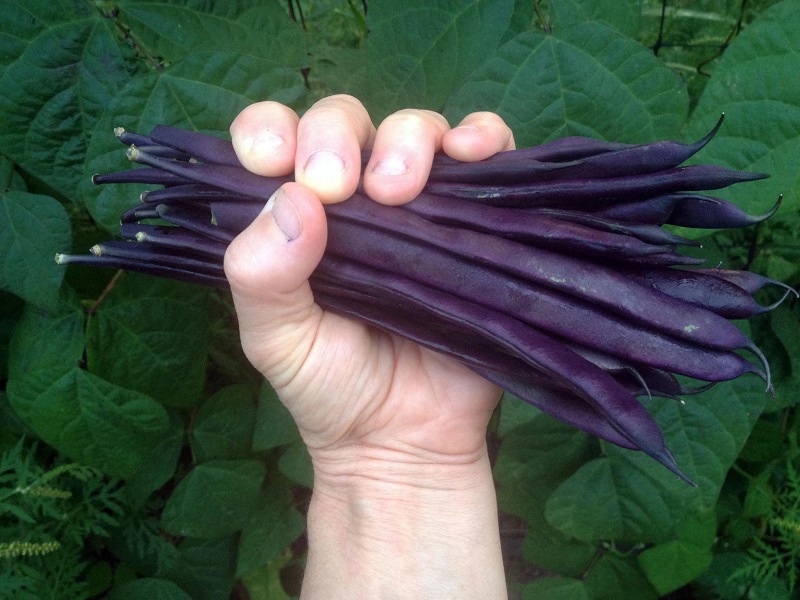
Purple pole beans are the most tolerant to loamy clay soil of all the bean varieties. It is hardy and not picky when it comes to watering. They grow in low-temperature conditions but also enjoy the full sun of summer.
Pole beans are ideal for harvest throughout their growth period, from premature beans and dried beans.
How to grow purple pole beans in clay soil?
Beans don’t like to be disturbed once they grow some roots. So, it’s not advisable to start them indoors. To make the soil ideal for beans to grow, you must add an adequate amount of organic matter.
Here are some of the conditions that you also need to take note of before growing purple pole beans:
- Temperature: 60 F to 80 F (below 60 F can slow down growth)
- Climate zones: USDA hardiness zones 3a to 10b
- Growing period: 67 to 70 days
- Soil pH: Neutral soil pH of 6.0–8.0
- Planting distance: 4 to 8 inches apart and 1 to 3 inches deep
- Fertilization: Add a thin layer of compost or fertilizers with higher levels of potassium and phosphorus. Beans naturally provide nitrogen in the soil, making them an ideal option for crop rotation with cabbages.
- Harvest: Harvest the purple pole beans in 70 to 100 days.
#6 Swiss Chard
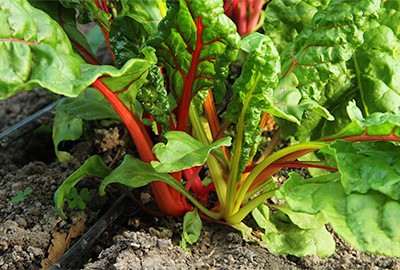
Swiss chard is another cool-loving vegetable that you can plant in clay soil. It is a crunchy addition to most salads and stir-fry dishes. Mix the clay soil with organic matter to achieve a lighter soil suitable for swiss chards.
The temperature during seed planting is crucial to the growth of swiss chard, which should be between 40 F to 50 F.
How to grow swiss chard in clay soil?
To jumpstart the germination of swiss chard seeds, you may soak them in water for 24 hours. Then, plant them in the ground or pots when the soil temperature gets warmer.
Clay soil provides a low temperature that the roots need throughout the growing period. You may also add mulch if your area receives harsh summer sun to retain the soil temperature.
Here are the other conditions that you should know before growing swiss chard in clay soil:
- Temperature: 40 F to 50 F (average daytime soil temperature)
- Climate zones: USDA hardiness zones 3 to 10
- Growing period: 55 to 60 days
- Soil pH: Neutral soil pH of 6.0–8.0
- Planting distance: 18 to 24 inches apart and 1 inch deep
- Fertilization: Add a thin layer of compost or general fertilizer before planting the seedlings or when the leaves and stems are small.
- Harvest: Begin harvesting your swiss chard when they reach about 6 to 8 inches in height. However, swiss chards are biennial, which means they can produce another set of stems and leaves in the next growing season. They become dormant in winter and bounce back in spring.
Final Thoughts
Our world holds a lot of secrets, and most scientists believe that we only know a fraction of it.
Clay soil, in particular, is not a popular option for growing plants but holds a lot of potential in being a growing medium for some varieties of vegetables.
Their best features like root support, moisture-holding capacity, and temperature control can support the needs of the plants that need them most.
Learning about the vegetables that grow in clay soil can give you hope that you can still utilize the clay soil in your garden and transform its bare and empty look into a lush garden.
We hope that this post has been informative and given you some idea of what to plant in your garden. We highly suggest that you begin breaking up the clay soil in your yard with daikon radish to improve its quality. Then, plant beans since they are nitrogen-giving plants that will enhance the fertility of the soil.
Let us know in the comments about your first harvest in your clay soil. There’s hope in clay soil, you just need to be more creative and add new organic matter to it to make it work.
Happy gardening!
